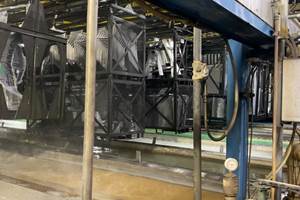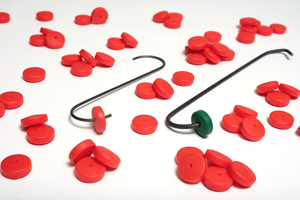Chemical Storage Tank Scrubbers Remove Venting Fumes
Tri-Mer’s chemical storage tank scrubbers use distinctive tower packing to remove venting fumes.
Chemicals stored in a tank typically don’t just sit dormant, waiting to be used. They produce inorganic fumes and gases that must be vented out to prevent the tank from collapsing or rupturing. Often, these fumes and gases are hazardous and can’t be released directly into the atmosphere, however. They first must be “scrubbed” of the dangerous chemicals they contain.
That is exactly what Tri-Mer Corp.’s chemical storage tank (CST) scrubbers are designed to do: handle fumes from the venting of bulk storage tanks, as well as the off-gases vented during tank filling, and reduce emissions of hazardous and/or corrosive vapors into the air.
“Systems can be designed for continuous or batch operation, such as during the transfer of chemical from tanker to bulk storage tank,” says Asa Halliday, sales engineer with Tri-Mer.
The packed-bed venting scrubbers use the company’s Tri-Packs tower packing media, which features distinctively shaped ribs, struts and drip rods designed to provide maximum surface contact between the gases and the scrubbing liquid, optimizing scrubbing efficiency and minimizing the depth of packing needed for effective operation.
“This shaping allows for superior wetting characteristics, low pressure drop and the ability to maintain uniform liquid distribution throughout the bed,” Halliday says.
And because there are no flat surfaces or minute openings in the packing media to harbor particulate, Tri-Packs also is said to significantly reduce clogging. Puddling also is reduced, because the packing is free of corners and valleys, and minimizes liquid flow down the wall surfaces. The tower packing also is designed to prevent dry spots and compression interlock, which are common to traditional packing media. Both conditions cause liquid and air channeling and diminish the efficiency of the scrubber, Halliday says.
“Efficiency requirements vary based on the regulatory agency and type of contaminant, however performance guarantees of greater than 99 percent removal are common,” he says.
Tri-Packs tower packing is available in four sizes in a variety of resins, including polypropylene, Kynar and glass-filled polypropylene. The CST scrubbers are constructed of polypropylene for most applications, although optional materials including high-alloy metals such as stainless and Hastelloy also are available. They can be installed indoors or out.
Systems can be engineered to the application, in airflow capacities of 200 to 50,000 acfm. According to Tri-Mer, factors that impact system design include the concentration of the acid or alkali in the tank; the type (pumped or pneumatic) and rate of transfer (air flow); whether there is tank breathing; the diameter, length and configuration of the transfer line; the pressure rating of the storage tank; the size of the vent; and whether scrubbing is continuous or batch.
Three configurations of CST scrubbers are available: single scrubber/single tank, multiple tank/multiple contaminants ducting to a single scrubber, and “emergency-release,” which is primarily for contaminants such as ammonia and chlorine in the event that a processing or storage room becomes compromised.
The scrubbers can be configured as standalone equipment with mechanical instrumentation or with control panels including monitoring systems, user interfaces, and alarms.
Tri-Mer Corp. | Owosso, Michigan | 989-723-7838 | tri-mer.comRelated Content
Installing an Ecoat Line
Thinking of investing in electrocoating capabilities? George Lovell, coatings plant manager for Lippert, discusses considerations you should keep in mind as you add your ecoat line.
Read More10 Ecoat Best Practices
Following this list of guidelines can help to increase the performance, cost effectiveness and quality for your ecoat operation.
Read MoreCFS Unveils New Hook Locks Parts Racking Solution
New product from Custom Fabricating & Supplies (CFS) prevents part loss during coating processes.
Read MoreTop Shop Leader Focuses on Its People as Key to Success
Twin Cities job shop, Avtec, was named a Top Shop for the third time in 2022, due in no small part to its commitment not only to the work it produces but to those who produce it — its employees.
Read MoreRead Next
Education Bringing Cleaning to Machining
Debuting new speakers and cleaning technology content during this half-day workshop co-located with IMTS 2024.
Read MoreA ‘Clean’ Agenda Offers Unique Presentations in Chicago
The 2024 Parts Cleaning Conference, co-located with the International Manufacturing Technology Show, includes presentations by several speakers who are new to the conference and topics that have not been covered in past editions of this event.
Read MoreEpisode 45: An Interview with Chandler Mancuso, MacDermid Envio Solutions
Chandler Mancuso, technical director with MacDermid Envio discusses updating your wastewater treatment system and implementing materials recycling solutions to increase efficiencies, control costs and reduce environmental impact.
Read More












.jpg;maxWidth=300;quality=90)









